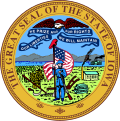| Elections in Iowa |
|---|
 |
The number of elections in Iowa varies from year to year. Presidential elections are held every four years.
Contents
- Electoral system
- Party system
- General elections
- Local elections
- Special elections
- See also
- References
- External links
| Year | Republican / Whig | Democratic | Third party(ies) | |||
|---|---|---|---|---|---|---|
| No. | % | No. | % | No. | % | |
| 1848 | 9,930 | 44.59% | 11,238 | 50.46% | 1,103 | 4.95% |
| 1852 | 15,856 | 44.84% | 17,763 | 50.23% | 1,745 | 4.93% |
| 1856 | 45,073 | 48.83% | 37,568 | 40.70% | 9,669 | 10.47% |
| 1860 | 70,302 | 54.61% | 55,639 | 43.22% | 2,798 | 2.17% |
| 1864 | 88,500 | 64.12% | 49,525 | 35.88% | 0 | 0.00% |
| 1868 | 120,399 | 61.92% | 74,040 | 38.08% | 0 | 0.00% |
| 1872 | 131,566 | 60.81% | 71,189 | 32.90% | 13,610 | 6.29% |
| 1876 | 171,326 | 58.50% | 112,121 | 38.28% | 9,431 | 3.22% |
| 1880 | 183,904 | 56.99% | 105,845 | 32.80% | 32,919 | 10.20% |
| 1884 | 197,089 | 52.25% | 177,316 | 47.01% | 2,796 | 0.74% |
| 1888 | 211,603 | 52.36% | 179,877 | 44.51% | 12,655 | 3.13% |
| 1892 | 219,795 | 49.60% | 196,367 | 44.31% | 26,997 | 6.09% |
| 1896 | 289,293 | 54.42% | 233,741 | 43.97% | 8,513 | 1.60% |
| 1900 | 307,808 | 58.04% | 209,265 | 39.46% | 13,282 | 2.50% |
| 1904 | 308,158 | 63.39% | 149,276 | 30.71% | 28,659 | 5.90% |
| 1908 | 275,209 | 55.62% | 200,771 | 40.58% | 18,789 | 3.80% |
| 1912 | 119,805 | 24.33% | 185,325 | 37.64% | 187,226 | 38.03% |
| 1916 | 280,439 | 54.25% | 221,699 | 42.89% | 14,806 | 2.86% |
| 1920 | 634,674 | 70.91% | 227,921 | 25.46% | 32,487 | 3.63% |
| 1924 | 537,458 | 55.02% | 160,382 | 16.42% | 278,930 | 28.56% |
| 1928 | 623,570 | 61.77% | 379,311 | 37.57% | 6,608 | 0.65% |
| 1932 | 414,433 | 39.98% | 598,019 | 57.69% | 24,235 | 2.34% |
| 1936 | 487,977 | 42.70% | 621,756 | 54.41% | 33,000 | 2.89% |
| 1940 | 632,370 | 52.03% | 578,800 | 47.62% | 4,260 | 0.35% |
| 1944 | 547,267 | 51.99% | 499,876 | 47.49% | 5,456 | 0.52% |
| 1948 | 494,018 | 47.58% | 522,380 | 50.31% | 21,874 | 2.11% |
| 1952 | 808,906 | 63.75% | 451,513 | 35.59% | 8,354 | 0.66% |
| 1956 | 729,187 | 59.06% | 501,858 | 40.65% | 3,519 | 0.29% |
| 1960 | 722,381 | 56.71% | 550,565 | 43.22% | 864 | 0.07% |
| 1964 | 449,148 | 37.92% | 733,030 | 61.88% | 2,361 | 0.20% |
| 1968 | 619,106 | 53.01% | 476,699 | 40.82% | 72,126 | 6.18% |
| 1972 | 706,207 | 57.61% | 496,206 | 40.48% | 23,531 | 1.92% |
| 1976 | 632,863 | 49.47% | 619,931 | 48.46% | 26,512 | 2.07% |
| 1980 | 676,026 | 51.31% | 508,672 | 38.60% | 132,963 | 10.09% |
| 1984 | 703,088 | 53.27% | 605,620 | 45.89% | 11,097 | 0.84% |
| 1988 | 545,355 | 44.50% | 670,557 | 54.71% | 9,702 | 0.79% |
| 1992 | 504,891 | 37.27% | 586,353 | 43.29% | 263,363 | 19.44% |
| 1996 | 492,644 | 39.92% | 620,258 | 50.26% | 121,173 | 9.82% |
| 2000 | 634,373 | 48.22% | 638,517 | 48.54% | 42,673 | 3.24% |
| 2004 | 751,957 | 49.90% | 741,898 | 49.23% | 13,053 | 0.87% |
| 2008 | 682,379 | 44.39% | 828,940 | 53.93% | 25,804 | 1.68% |
| 2012 | 730,617 | 46.18% | 822,544 | 51.99% | 29,019 | 1.83% |
| 2016 | 800,983 | 51.15% | 653,669 | 41.74% | 111,379 | 7.11% |
| 2020 | 897,672 | 53.09% | 759,061 | 44.89% | 34,138 | 2.02% |
| 2024 | 927,019 | 55.73% | 707,278 | 42.52% | 29,209 | 1.76% |
Since 1972, Iowa has been the first state to vote in presidential primaries, with their caucuses. As with presidential elections, gubernatorial elections are held every four years - but are staggered such that they are held on general elections independently of the presidential election. Members of the Iowa Senate are elected every four years, with half of the Senate elected at each general election; all members of the Iowa House of Representatives are elected every two years. Additionally, elections for various government officials, judicial retention elections, and elections on referendums occur as part of various elections in Iowa.
In a 2020 study, Iowa was ranked as the 24th easiest state for citizens to vote in. [2]
